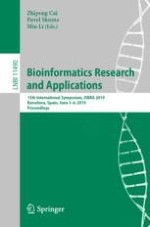2019 | OriginalPaper | Chapter
Simultaneous Multi-Domain-Multi-Gene Reconciliation Under the Domain-Gene-Species Reconciliation Model
Authors : Lei Li, Mukul S. Bansal
Published in: Bioinformatics Research and Applications
Publisher: Springer International Publishing
Activate our intelligent search to find suitable subject content or patents.
Select sections of text to find matching patents with Artificial Intelligence. powered by
Select sections of text to find additional relevant content using AI-assisted search. powered by
